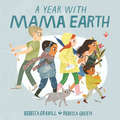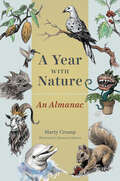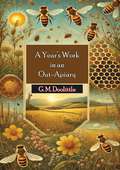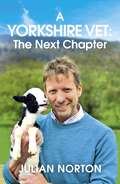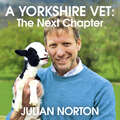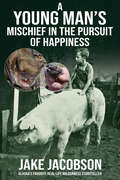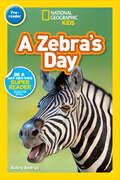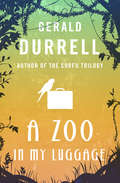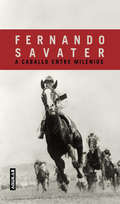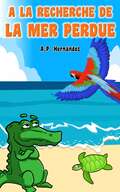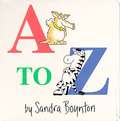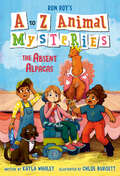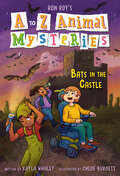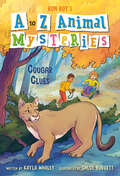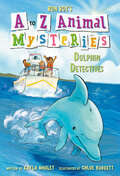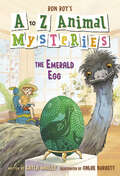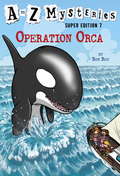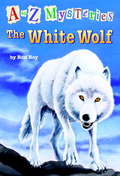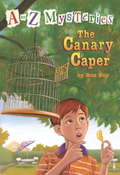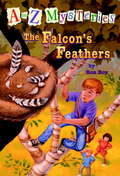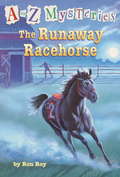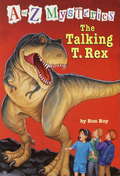- Table View
- List View
A Year on the Farm (Season to Season)
by Christina Mia GardeskiFrom mending fences to seedlings and combines, life on the farm changes from season to season. Discover what farmers do in winter. Learn how crops are harvested in fall. Real-life photographs follow the seasons and capture the beauty of a year on the farm.
A Year with Mama Earth
by Rebecca GrabillIn September, Mama Earth sighs out the first autumn frost, which crunches under children&’s feet. Mama Earth looks after nature&’s plants and animals throughout the year—singing lullabies to fat bears in the fall, dressing evergreens in icicles in winter, and waking up the crocuses in spring. And in the summer, Mama Earth sends warm sunbeams to her beloved children, so they can play outside and enjoy the amazing world around them.With enchanting text and radiant artwork, A Year with Mama Earth offers a joyous celebration of nature&’s beauty and the changing seasons.
A Year with Nature: An Almanac
by Marty Crump Bronwyn McIvorA Year with Nature is an almanac like none you’ve ever seen: combining science and aesthetics, it is a daily affirmation of the extraordinary richness of biodiversity and our enduring beguilement by its beauty. With a text by herpetologist and natural history writer Marty Crump and a cornucopia of original illustrations by Bronwyn McIvor, this quirky quotidian reverie gazes across the globe, media, and time as it celebrates date-appropriate natural topics ranging from the founding of the National Park Service to annual strawberry, garlic, shrimp, hummingbird, and black bear festivals. With Crump, we mark the publication of classics like Carson’s Silent Spring and White’s Charlotte’s Web, and even the musical premiere of Tchaikovsky’s Swan Lake. We note the discovery of the structure of DNA and the mountain gorilla, the rise of citizen science projects, and the work of people who’ve shaped how we view and protect nature—from Aristotle to E. O. Wilson. Some days feature US celebrations, like National Poinsettia Day and National Cat Day; others highlight country-specific celebrations, like Australia’s Wombat Day and Thailand’s Monkey Buffet Festival, during which thousands of macaques feast on an ornately arranged spread of fruits and vegetables. Crump also highlights celebrations that span borders, from World Wildlife Conservation Day to International Mountain Day and global festivities for snakes, sea turtles, and chocolate. Interweaving fascinating facts on everything from jellyfish bodies to monthly birth flowers with folkloric entries featuring the Loch Ness Monster, unicorns, and ancient Greek, Roman, and Egyptian mythology, the almanac is as exhaustive as it is enchanting. A Year with Nature celebrates the wonder and beauty of our natural world as we have expressed it in visual arts, music, literature, science, natural history, and everyday experience. But more than this, the almanac’s vignettes encourage us to contemplate how we can help ensure that future generations will be able to enjoy the landscapes and rich biodiversity we so deeply cherish.
A Year's Work in an Out-Apiary: Or an Average of 114½ Pounds of Honey Per Colony in a Poor Season, and How It Was Done
by G. M. DoolittleA Year’s Work in an Out-Apiary by G. M. Doolittle is a practical and insightful guide to beekeeping, offering a detailed account of how the author achieved exceptional honey yields despite challenging conditions. Doolittle, a pioneer in modern beekeeping methods, shares his expertise and techniques for managing an out-apiary—an apiary located away from the beekeeper’s residence—demonstrating how attentive care, strategic planning, and innovative practices can lead to success even in poor seasons.The book takes readers through the entire beekeeping year, month by month, covering essential tasks such as colony management, swarm control, queen rearing, and disease prevention. Doolittle offers clear, actionable advice on how to optimize hive productivity, improve honey yields, and maintain healthy colonies. His narrative reflects both scientific precision and a deep passion for beekeeping, making it a valuable resource for beginners and experienced apiarists alike.Doolittle emphasizes the importance of understanding bee behavior and adapting practices to the environmental conditions of each season. He explains how to select optimal locations for out-apiaries, manage hives to prevent swarming, and maximize nectar flow periods. His work also includes insights on troubleshooting common problems, from queen issues to weather challenges, providing practical solutions to ensure steady production.More than just a technical manual, A Year’s Work in an Out-Apiary serves as a testament to the rewards of patience, observation, and dedication in the art of beekeeping. Doolittle’s achievement of harvesting 114½ pounds of honey per colony in a poor season stands as an inspiring example of what is possible through thoughtful effort.This book remains a classic in the field, offering both practical knowledge and timeless wisdom to those interested in beekeeping. Whether you are a hobbyist or a professional beekeeper, Doolittle’s guidance provides invaluable tools to help you achieve sustainable success in your apiary.
A Yorkshire Vet: The Next Chapter
by Julian NortonAs seen on This Morning!'A magical memoir.' - Daily Mail WeekendOur Yorkshire Vet embarks on this newest adventure treating the animals and their assorted owners across the Yorkshire Dales.A Yorkshire Vet: The Next Chapter follows Julian's veterinary stories and amusing anecdotes through his work as a mixed practice vet in North Yorkshire.Julian has spent over twenty years working in Thirsk, literally following in the footsteps of James Herriot - the world-renowned vet and author. This book follows Julian's passion for treating the animals under his care, be they cows, sheep, pigs, horses, alpacas or dogs and cats, along with the interesting and amusing characters who own and care for them. His voice, well known from his television work, rings out from the page - as does the humour, dedication and love for the animals. A Yorkshire Vet: The Next Chapter tracks Julian's work around the beautiful North York Moors and, more recently, around the Vale of York and the Yorkshire Dales from his new veterinary home in Boroughbridge, where the Herriot spirit lives on!
A Yorkshire Vet: The Next Chapter
by Julian NortonAs seen on This Morning!'A magical memoir.' - Daily Mail WeekendOur Yorkshire Vet embarks on this newest adventure treating the animals and their assorted owners across the Yorkshire Dales.A Yorkshire Vet: The Next Chapter follows Julian's veterinary stories and amusing anecdotes through his work as a mixed practice vet in North Yorkshire.Julian has spent over twenty years working in Thirsk, literally following in the footsteps of James Herriot - the world-renowned vet and author. This book follows Julian's passion for treating the animals under his care, be they cows, sheep, pigs, horses, alpacas or dogs and cats, along with the interesting and amusing characters who own and care for them. His voice, well known from his television work, rings out from the page - as does the humour, dedication and love for the animals. A Yorkshire Vet: The Next Chapter tracks Julian's work around the beautiful North York Moors and, more recently, around the Vale of York and the Yorkshire Dales from his new veterinary home in Boroughbridge, where the Herriot spirit lives on!
A Yorkshire Vet: The Next Chapter
by Julian NortonThe Yorkshire Vet embarks on this newest adventure treating the animals and their assorted owners across the Yorkshire Dales.A Yorkshire Vet: The Next Chapter follows Julian's veterinary stories and amusing anecdotes through his work as a mixed practice vet in North Yorkshire.Julian has spent over twenty years working in Thirsk, literally following in the footsteps of James Herriot - the world-renowned vet and author. This book follows Julian's passion for treating the animals under his care, be they cows, sheep, pigs, horses, alpacas or dogs and cats, along with the interesting and amusing characters who own and care for them. His voice, well known from his television work, rings out from the page - as does the humour, dedication and love for the animals. A Yorkshire Vet: The Next Chapter tracks Julian's work around the beautiful North York Moors and, more recently, around the Vale of York and the Yorkshire Dales from his new veterinary home in Boroughbridge, where the Herriot spirit lives on!(P) 2020 Hodder & Stoughton Ltd
A Young Man’s Mischief in the Pursuit of Happiness
by Jake JacobsonSpending the summers of 1958 through 1960 on a large ranch south of Cascade, Montana, as a teenager, I learned a lot about ranching—and life. Teams of horses were used for much of the work, and buckboard wagons were used daily. Technology-wise, this ranch was about thirty years behind the times, but it made a profit for the absentee owner, and it was a wonderful way of life.
A Zany Competition (Fountas & Pinnell LLI Red #Level M)
by Jacqueline Adams"Worm charming? It started as a crazy contest at a school in England. Now it's an event that attracts thousands of people - and thousands of worms!"
A Zebra's Day (Readers)
by Aubre AndrusFollow a zebra throughout the day as it grazes and spends time with its herd in its grassland habitat.Zebras are one of Africa's most interesting animals, and in this pre-reader, young readers will learn all about where they live, what they eat, and how they survive in the herd. Perfect for beginning and young readers, National Geographic Pre-readers include simple, expert-vetted text and large, engaging photos on every page. A vocabulary tree at the beginning of the book introduces kids to key words in concept groups, helping them make connections between words. Plus, a wrap-up activity gives kids a chance to use what they've learned, while expanding their knowledge of the world.
A Zoo in My Luggage: A Zoo In My Luggage, The Whispering Land, And Menagerie Manor (The Zoo Memoirs #1)
by Gerald DurrellA British naturalist and his wife acquire a menagerie of animals and set up their own zoo in this delightful memoir by the author of the Corfu Trilogy.For many years I had wanted to start a zoo. . . . Any reasonable person smitten with an ambition of this sort would have secured the zoo first and obtained the animals afterwards. But throughout my life I have rarely if ever achieved what I wanted by tackling it in a logical fashion. After a decade of supplying creatures for other people&’s zoos, in 1957 Gerald Durrell and his wife set off on an adventurous journey to the Cameroons in West Africa, where they collected numerous mammals, birds, and reptiles. The wild nature of the animals created quite a bit of chaos, but the Durrells&’ problems really began when they attempted to return to Britain with their exotic new friends. Not only did they have to get them safely home, they also had to find somewhere able and—more importantly—willing to house them. Told with wit and a zest for all things furry and feathered, Durrell&’s A Zoo in My Luggage is a brilliant account of how a pioneer of wildlife preservation came to found a new type of zoo. This ebook features an illustrated biography of Gerald Durrell including rare photos from the author&’s estate.
A caballo entre milenios
by Fernando SavaterUn libro que admite múltiples lecturas: crónica deportiva, libro de viajes, relato de aventuras, reflexión sobre los gozos y las sombras en el cruce de dos siglos... Al hilo de la búsqueda apasionada de la carrera de caballos ideal, el autor recorre el mundo, desde Buenos Aires a Dubai, desde San Sebastián a Hong Kong y Tokio, sin olvidar los grandes hipódromos clásicos de Kentucky, Epsom o Longchamp. En esas travesías se cruza con la presencia y la memoria de los mejores caballos que han existido, con obras literarias y con películas, pero también con las preocupaciones de la actualidad política y social: el terrorismo, las drogas, la diversidad cultural, la democracia... Y siempre con las mil caras del amor a la vida y las mil amenazas de la muerte. Un diario singular del año dos mil para los lectores del siglo XXI.
A la recherche de la mer perdue: Livre pour enfants de 6 ans
by A. P. HernándezMarina est une tortue marine tres speciale. A peine venue au monde et rien ne peut ouvrir les yeux au monde, se rend compte de ce qu'elle s'est perdue. Ou est la mer? Ou sont ses freres? Pourquoi elle est seule? Elle n'a pas de temps a perdre. Elle doit rencontrer la mer, son horreur, et a un large chemin pour avant...
A to Z
by Sandra BoyntonSerious silliness for all ages. Artist Sandra Boynton is back and better than ever with completely redrawn versions of her multi-million selling board books. These whimsical and hilarious books, featuring nontraditional texts and her famous animal characters, have been printed on thick board pages,and are sure to educate and entertain children of all ages. Limited picture descriptions present.
A to Z Animal Mysteries #1: The Absent Alpacas (A to Z Animal Mysteries #1)
by Ron Roy Kayla WhaleySolve Animal Mysteries from A to Z! Young clue hunters Abbi, Daniel, and Lydia sniff out the mystery behind a group of missing alpacas. Inspired by Ron Roy's beloved A to Z Mysteries series, this spin-off is perfect for budding young chapter-book readers--and future detectives!A is for ALPACAS . . .It's time for the alpaca costume contest, and Abigail "Abbi" Wallace is excited to see it at the Maine State Fair. But there&’s only one alpaca left—the rest are missing! What sent the alpacas packing? Abbi; her dog, Barkley; and her friends Lydia and Daniel are ready to sniff out this mystery!DON'T MISS the original A to Z Mysteries series by Ron Roy, starting with The Absent Author!
A to Z Animal Mysteries #2: Bats in the Castle (A to Z Animal Mysteries #2)
by Ron Roy Kayla WhaleyInspired by Ron Roy's A to Z Mysteries series, this bright and modern animal adventure story is perfect for budding young chapter book readers. This time, Abbi and her friends are determined to rescue a lost bat!Solve Animal Mysteries from A to Z! Abbi, Lydia, and Daniel love to watch bats flying around their neighborhood after sunset. Nature is so cool! But then they hear an unnatural sound in Abbi's home. Is it a ghost? Or something scarier? With help from her trusty dog Barkley, Abbi and her friends will shine a light on the truth!Don't miss the first book in this series: A to Z Animal Mysteries #1: The Absent Alpacas.Did you know there's an original A to Z Mysteries series that has been beloved by kids for generations? Check out all 40 books in the A to Z Mysteries series by Ron Roy where kids Dink, Josh, and Ruth Rose solve mysteries from A to Z in their hometown and beyond!
A to Z Animal Mysteries #3: Cougar Clues (A to Z Animal Mysteries #3)
by Ron Roy Kayla WhaleySolve Animal Mysteries from A to Z! Join Abbi and her friends on the hunt for proof of a cougar in the woods! Inspired by Ron Roy's A to Z Mysteries series, this bright and modern animal adventure story is perfect for budding young chapter book readers.No one has seen cougars in Maine for more than a hundred years. Then, a TV crew starts filiming in the woods near Abbi's home, looking for cougars! Abbi, Lydia, and Daniel are curious: could this sly animal have returned to Maine? All clues point to YES! -- but something doesn't quite add up. . . .Don't miss the first books:A to Z Animal Mysteries #1: The Absent Alpacas A to Z Animal Mysteries #2: Bats in the CastleReady for more? Check out the original A to Z Mysteries series by Ron Roy where kids Dink, Josh, and Ruth Rose solve mysteries from A to Z in their hometown and beyond!
A to Z Animal Mysteries #4: Dolphin Detectives (A to Z Animal Mysteries #4)
by Ron Roy Kayla WhaleySolve Animal Mysteries from A to Z! Inspired by Ron Roy's A to Z Mysteries series, this exciting animal adventure mystery is perfect for budding young chapter book readers. This time, 8-year-old Abbi and her friends solve a mystery with the help of dolphins!It's the weekend -- a perfect day for a sail off the coast of Maine. But there's something fishy going on with the local dolphins and Abbi, Lydia, and Daniel are determined to find out why. Are the dolphins twisting, leaping, and whistling because they're playing? Or is it a warning of nearby danger? And if it's danger, how can the kids get grownups to believe them? Abbi and her friends are diving head first into this mystery!Don't miss the first books in the A to Z Animal Mysteries series:#1: The Absent Alpacas#2: Bats in the Castle#3: Cougar CluesReady for more? Check out the original A to Z Mysteries series by Ron Roy!
A to Z Animal Mysteries #5: The Emerald Egg (A to Z Animal Mysteries)
by Ron Roy Kayla WhaleySolve Animal Mysteries from A to Z! Inspired by Ron Roy's A to Z Mysteries series, this exciting animal adventure mystery is perfect for budding young chapter book readers. This time, 8-year-old Abbi and her friends solve the mystery of missing emu egg!E IS FOR EMU EGG . . .Crack that case! While visiting her cousin in Australia, Abbi learns that a valuable carved emu egg has been stolen. Who is the thief? Could it be Abbi's aunt who hates the egg? Or the visiting couple who likes to collect rare items? Or. . . is it Abbi's favorite cousin? With the help of her friends, Abbi and her friends, Lydia and Daniel, will crack this case wide open!Don't miss the first books in the A to Z Animal Mysteries series:#1: The Absent Alpacas#2: Bats in the Castle#3: Cougar Clues#4: Dolphin DetectivesReady for more? Check out the original A to Z Mysteries series by Ron Roy!
A to Z Mysteries Super Edition #7: Operation Orca
by Ron Roy John Steven GurneyThar she blows! Dink, Josh, and Ruth Rose are on an Alaskan whale watching adventure. On their first day, they see a mother orca and her calf. But the next day, the baby orca is missing! The calf needs its mother's milk. Can the kids solve this whale of a mystery? The alphabet is over, but the mysteries continue in this seventh A to Z Mysteries Super Edition, featuring a 26-letter secret message hidden in the illustrations.
A to Z Mysteries: A To Z Mysteries (A to Z Mysteries #23)
by Ron Roy John Steven GurneyDon't miss A to Z Mysteries--alphabetic adventures that are full of thrills, chills, and cases to crack! W is for Wolf... In the twenty-third book of the A to Z Mysteries--an early chapter book mystery series featuring strong boy and girl characters--Dink, Josh, and Ruth Rose are thrilled to visit Wallis Wallace at her new cabin in the Maine wilderness. On their very first day, they glimpse a white mother wolf and her babies on a cliff nearby. But soon after the kids spy the wolf family, the pups are stolen! Can Dink, Josh, and Ruth Rose sniff out the culprits before the white wolf starts suspecting them? Each book includes a map in the front. Parents, teachers, and librarians agree that these highly collectible chapter books are perfect for emerging readers and any kid who love mysteries!From the Trade Paperback edition.
A to Z Mysteries: The Canary Caper
by Ron RoyC is for Canary...Dink, Josh, and Ruth Rose get an urgent call from Mrs. Davis. Her canary is missing! The little bird has vanished without a trace, and he's not the only one. Two other pets are missing. The kids suspect a pet-napper, and now that Ruth Rose's cat, Tiger, has turned up missing too, it's become personal! From the Trade Paperback edition.
A to Z Mysteries: The Falcon's Feathers
by Ron RoyF is for Falcon...When Josh discovers a nest of young falcons in the forest, he, Dink, and Ruth Rose start visiting every day. Until the morning they find it empty! Then the kids discover a wounded falcon with its wing feathers clipped, and they know someone's up to no good. Can they figure out what's going on before it's too late to save the falcons? From the Trade Paperback edition.
A to Z Mysteries: The Runaway Racehorse (A to Z Mysteries #18)
by Ron Roy John Steven GurneyDon't miss A to Z Mysteries--alphabetic adventures that are full of thrills, chills, and cases to crack! R is for Racehorse... In the eighteenth book of the A to Z Mysteries--an early chapter book mystery series featuring strong boy and girl characters--Dink, Josh, and Ruth Rose are excited to see Uncle Warren's new racehorse, Whirlaway, in action. But the night before the big race, the horse disappears! He shows up the next day, just in time to lose the race. Why is Whirlaway suddenly so slow? Can the kids figure it out - or is Whirlaway out of the winner's circle for good? Each book includes a map in the front. Parents, teachers, and librarians agree that these highly collectible chapter books are perfect for emerging readers and any kid who love mysteries!From the Trade Paperback edition.
A to Z Mysteries: The Talking T. Rex (A to Z Mysteries #20)
by Ron Roy John Steven GurneyDon't miss A to Z Mysteries--alphabetic adventures that are full of thrills, chills, and cases to crack! T is for T. Rex... In the twentieth book of the A to Z Mysteries--an early chapter book mystery series featuring strong boy and girl characters--Green Lawn meets its newest - and biggest - visitor; Tyrone the Tyrannosaurus! The kids' old friend Jud Wheat is in town, and he's raising finds for a dinosaur museum by taking the T. Rex on tour. But after the show in Green Lawn, all Jud's money disappears! Can Dink, Josh, and Ruth Rose track down the cash and rescue Jud from this prehistoric pickle?Each book includes a map in the front. Parents, teachers, and librarians agree that these highly collectible chapter books are perfect for emerging readers and any kid who love mysteries!From the Trade Paperback edition.

